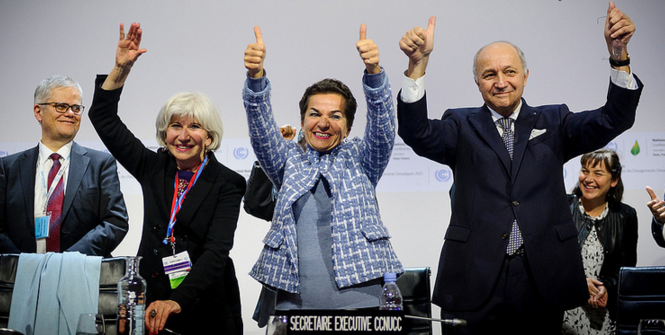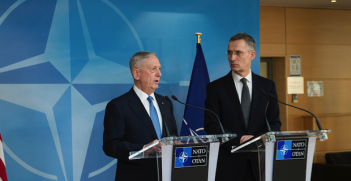COP21: Beyond the Landing Zone in the City of Light

The final plenary of the Paris Climate Conference was like Woodstock for climate negotiators and their devotees. Even before Laurent Fabius, President of the Paris COP, French foreign minister and former prime minister, took the chair, there were clear signs of jubilation among delegates and observers. Love was in the air. It was the dawning of the Age of Renewables.
The Paris Agreement is the first scientifically informed, legally binding climate agreement applicable to all. Critically, it is the first international agreement that might begin to avert the threat of dangerous climate change. Nevertheless, the level of ambition of the Paris deal – and its content – were uncertain when the conference began. And there was always the opportunity for some key issues to go off the rails during two gruelling weeks of deliberations.
Two key outcomes
It is hard to talk about Paris’ substantive successes with the ink barely dry on the page. At present, the Agreement is a promissory note and is the inevitably flawed result of compromise. But its high level of defined ambition is sufficient to drive mitigation powerfully over the next decade and to set the foundations for achieving its goal.
The deal is important for its handling of two main clusters of issues: targets, long term ambition and the ‘ratcheting mechanism’; and climate finance, loss and damage and compensation. These were framed by persistent concerns about differentiation, equity and responsibility, and the long and deeply embedded debate about common but differentiated responsibilities and the respective roles of rich and poor parties.
Targets, long term ambition and “ratcheting up”
2015 will be the hottest year ever recorded. Fittingly, the Paris Agreement contains the strongest temperature goal of any international climate deal so far.
It aims to hold warming ‘to well below 2 degrees Celsius above pre-industrial levels and to pursue efforts to limit the temperature increase to 1.5 degrees Celsius above pre-industrial levels’. This aim frames and drives the Agreement’s ambition. It recognizes the reality – and the recent shift in scientific thinking – that 2 degrees warming above pre-industrial levels constitutes dangerous climate change.
Robust reference to 1.5 degrees was strongly contested during the COP. It was opposed by Saudi Arabia, while the Like Minded Group of Developing Countries (including China and India) which saw this as an impediment to their development if not accompanied by additional finance.
By contrast, a broad Alliance of High Ambition states, championed by the Marshall Islands and including United States, the EU and some 79 African, Caribbean and Pacific Island states, sought tougher phrasing.
There was no chance of a Paris deal without a significant recognition in the Agreement of the concerns of the small island developing states (SIDS) bloc. Vocal in 2009, they had come to understand that warming above 1.5 degrees would cause intolerable damage to low-lying countries and now were implacably opposed to a deal without strong reference to this goal.
Current emissions have almost committed our planet to that 1.5 degrees level of warming and so one sceptical negotiator observed ‘the inclusion of these unrealistic targets merely recognizes the desperate need of climate vulnerable states, buys their support, weakens their resistance on other issues and helps split the developing state bloc’.
Meanwhile the aggregate effort of current INDCs is insufficient and will lead to warming of at minimum 2.7 degrees. The Agreement acknowledges the gap between its goal and the emissions arising under the current INDCs but it does not press hard for actual implementation of these inadequate pledges. Nor does the deal contain a process for ensuring the INDCs’ ambition and goals will be ratcheted up before 2025, and perhaps 2030.
Yet cynicism misses the point. The new goal is not empty symbolism. Holding warming to well below 2 degrees is still achievable and has substantial real-world implications. The goal provides a narrative about the urgency of action, strengthens expectations for rapid mitigation both by governments and business and further intensifies pressure for funding transfers to the developing world to assist this outcome.
Climate finance, loss and damage, and compensation
Climate finance was the second trip-wire for Paris. It was the issue which delayed the final deal and at times seemed capable of sinking the negotiations. The major developing country bloc (G77 plus China) held firm to the view that the rich countries of the North must fund mitigation and adaptation by the South.
The capacity of developing countries and, especially poor and climate vulnerable states, to meet the costs of adaptation and climate-related loss and damage is slight. This is the clearest manifestation of the concern about “differentiation” between rich and poor countries, based on their historical responsibility for global warming and in the wealth derived from use of fossil fuels.
The 2009 Copenhagen Accord was its precedent: the Accord was only agreed when developed countries, led by the United States, promised to establish a Green Climate Fund (GCF) to provide $100 billion per annum for developing countries by 2020.
However voluntary commitments to the GCF by developing countries have been slow to manifest since then. At present they rest at around $65 billion per annum and there was, prior to Paris, no indication of the future of funding beyond that date.
There was a bitter struggle at the Paris COP over whether all parties – or only developed countries – have responsibilities in providing climate finance. The final Agreement is a weak compromise: it does nothing to require developed states to contribute to the level of $100 billion by 2020 and it is not until 2025 that parties are collectively required go beyond this figure as a base for further funding.
Moreover, the complex issue of funding for loss and damage – while included in the text – was essentially deferred until next year’s negotiations. It certainly had the capacity to break this Agreement, particularly as it was seen to have the potential to creep into the legal space of compensation which is a “red line” issue for developed countries..
Implications for Australia
Australia was caught flat-footed at Paris trying to run with the hares and hunt with the hounds. Prime Minister Turnbull’s opening speech offered nothing of substance beyond the extension to 2020 of its existing annual contribution to the Green Climate Fund. The COP was grateful for his urbanity and optimism but in the corridors delegates quietly acknowledged the vacuity of his “innovation” rhetoric.
Australia was also notably absent from the launch of the Alliance of High Ambition, with its 100 developed and developing countries. When Minister Bishop announced that Australia had indeed joined this “coalition of ambition” she was politely rebuffed by Tony de Brum, foreign minister of the tiny Marshall Islands and the Alliance’s founder, who insisted Australia was not a member yet but he looked forward ‘to hearing what more they may be able to do to join our coalition of high ambition here in Paris’.
The ambitious goals of the Paris Agreement have increased the gulf between current domestic policy and what is required. To bridge this gap Australia will have to increase not only its targets and mitigation effort for 2020, but also its ambitions for 2030.
Associate Professor Peter Christoff teaches climate policy in the School of Geography at the University of Melbourne. He attended the COP21 in Paris. This article can be republished under a Creative Commons License.





